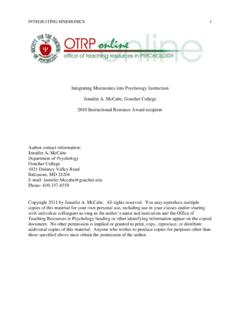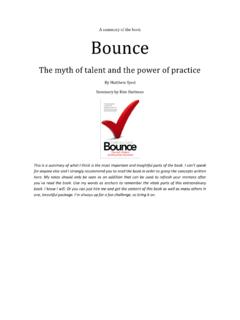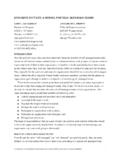Transcription of Speed Training: Improving Acceleration for …
1 Speed training : Improving Acceleration for optimal performance By Introduction The ability to accelerate is an important quality to possess in sports such as Track athletics, Rugby, American Football, Soccer and Basketball. The worlds fastest men (Usain Bolt, Asafa Powell, Tyson Gay), and women spend a large amount of their time training to hone this most important of skills. The ability to accelerate allows Rugby players like Brain Habana, Jason Robinson and Jos Lewsey to evade the opposition. In this post, we will analyse the mechanics and major muscles (also known as prime movers) fundamental to high performance Acceleration . We will then suggest training methods to develop this most important quality for speedsters of all running sports.
2 Description of Acceleration mechanics At the start of a run or sprint, athletes have to assume a favourable position to accelerate their body. This position is characterised by a lean forward with the support or drive leg behind the body. An example is the start and Acceleration position of the 100m in Track and Field. The Acceleration mechanics can be characterised by a long stance phase and a floating phase that is short. This position allows the athlete to apply more force and recruit muscle mass to overcome gravity. Starting and Acceleration differ enormously from constant Speed or maximal Speed . The foot spends a longer time (circa 180-250ms) on the ground and because of the lack of pre-stretch of the achilles tendon (relative to the constant Speed phase) muscular strength is a significant factor for success.
3 This type of strength is classified as explosive muscular strength. The foot is in a flatter position when making contact with the ground with very little rebound. Constant Speed is characterised by a reactive action relying on the stretch-shortening of tendons, ligaments and muscles. The difference between the two phases of sprinting are the reasons why a sprinter can be world class at 60m yet an also run at 100m. Obviously the 100m requires a longer constant Speed phase encompassing phases of maximal Speed . Fig 1:The correct body form and position for optimal Acceleration Biomechanics At the start, when the body is hanging forward, the back must be kept stiff and straight without any rounding, this is true for all Acceleration patterns regardless of the sport in question.
4 The lean can be achieved by bending the spine with a slight pelvic tilt (bending at the waist). Rounding of the back will weaken the role of the back muscles responsible for keeping the body and spine straight. The muscles responsible for this role are the erector spinae. A slight bend in the back at the waist allows the ES to participate in Acceleration yet a rounding of the back diminishes the response. The ES is capable of rotating the pelvis and so can transfer energy through the pelvis, using the pelvis to aid the legs to apply force to the ground. The strength of the ES and latissmus dorsi is crucial in aiding an athlete to maintain the lean during Acceleration .
5 The stronger the dorsal and erector muscles the longer the athlete can hold the position and so prolong the Acceleration phase. An often ignored but crucial area for success in Acceleration is the development of upper body strength. Arm action can contribute to the force applied by a sprinter to the track. Fast explosive arm drive allows a stabilisation of the body but also takes advantage of the global workings of the central nervous system. As you move your arms explosively, the signals sent to the prime-movers also spill-over to the legs. The more forceful and explosive the arm drive, the more forceful and explosive will be the leg drive. Muscles of the shoulder complex and the upper back along with arm muscles contribute to stability and propulsion.
6 The latissmus dorsi, trapezius, and deltoids are the prime movers in the arm drive, helping to mobilise the shoulder joint. Strong biceps and triceps will aid Acceleration of the arms also. Quick mention should also be given to the neck. The neck has to be in line with the back, without bracing of the neck, the head alignment will cause Acceleration to be less efficient. A neck brace used by boxers could come in useful for developing neck strength, this in particular will favour Rugby players in particular when they are tackled by the opposition, the neck will be able to react faster on impact to protect the spine. Fig 2:The major muscles involved in Acceleration Push-off can be strengthened by extending the ankle, knee and hip joint simultaneously; this is also known as triple extension.
7 Hip and knee extension are compatible at stance phase and so the role of the rectus femoris is decisive in the Acceleration phase. In short, the RM acts as a transmitter of energy between the two joints. The gluteaus maximus and quadriceps are the engines that generate force during the Acceleration phase. The gluteaus maximus transmits its force to the knee through the ilio-tibial band and through the rectus femoris. The gastrocnemius transmits force from the knee to the ankle joint. The gastrocnemius acts very differently from the constant Speed mechanics of sprinting, it has no rebound and so the muscle fibers in the gastro have to be able to provide the necessary forces.
8 During the Acceleration the generation of force is the most important factor. A runner has to maintain stretch forcefully because a fast stretch wouldn t allow enough time for application of muscular explosive strength. Thrust forces are more horizontally directed than running at constant Speed . Inter-muscular co-ordination is very important . During Acceleration , there is no pre-loading of hamstrings and outer pendulum swing of the leg. What takes place on the ground is decisive during Acceleration and what takes place in the air is decisive at max Speed . There is little landing energy to process during the stance phase of the Acceleration and so greater force can be generated The optimal angle for Acceleration is 45 degrees but stronger athletes can manage more acute angles for the initial strides.
9 Whether a sprinter, rugby player, soccer player or, the optimal angle of 45 degrees is the ideal but as the athlete becomes stronger, a more acute angle can be utilised. Arm action should be vigorous and purposeful, with an emphasis on the shoulder joint. The head should be in line with the back, but in team sports, players need to see the opposition and team members and so it is not a hard and fast rule. Exercises to develop the qualities of Acceleration . As mentioned earlier in this post, the Acceleration is determined by the strength qualities of the prime movers and the angle of the body in relation to the ground. To develop explosive muscular strength, there are many methods that can be utilised.
10 Each can replace or compliment the other, but the most important quality to possess is high levels of maximal strength. There is no conflict between the possession of maximal strength and the acquisition of explosive strength. A higher level of muscular strength allows an athlete to readily obtain explosive strength. Below, you will find a range of possible methods for developing Acceleration mechanics and strength. Resistance training Resistance training is the most popular means of obtaining strength and power in modern sports training . Resistance training can be used to develop maximal strength efficiently. A Load of 80-100% is sufficient to develop maximal strength.






